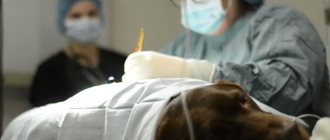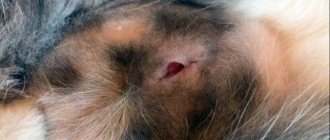Even with a successful operation, caring for the dog after sterilization is extremely necessary. If the animal is treated incorrectly during the period of its rehabilitation, all the efforts of the surgeon will be nullified and the dog will definitely need the help of a veterinarian. The pet owner should keep in mind those symptoms that require contacting a specialist. It is important to know how to speed up the animal’s recovery process and what dog behavior can be considered normal.
At what age is surgery performed?
There is a misconception that male dogs are castrated and females are spayed. In fact, both types of surgery are available for dogs of both sexes. The first type involves removing the testes or uterus and ovaries, the second involves ligating the fallopian tubes or spermatic cords.
A huge disadvantage of sterilization is that the dog’s desire does not disappear and all manifestations of sexual behavior are preserved. Castration brings peace not only to the owner, but also to the animal itself.
Expert opinion
Anna Abramenko
An avid dog lover. Experience in veterinary medicine since 2009.
Ask a Question
Castration or sterilization too early can lead to unpredictable consequences, including problems with the genitourinary system
The right time for the operation is the first thing that owners think about. The best moment is considered to be the beginning of puberty. The dog’s sexual instinct has not yet fully formed; it does not mark its territory. At the same time, the development of the body is coming to an end, the operation will not harm it.
It is better to castrate males at 7-8 months. This applies to small dogs. For large breeds, a period of 1-1.5 years is optimal. It is customary to operate on female dogs before their first heat, at the age of 6-9 months.
Castration and sterilization are also acceptable for adults. But you need to take into account that their health is no longer as strong as that of puppies, so the risk of complications increases, the stitches take a long time to heal, and the dog’s rehabilitation process is delayed.
This is interesting: What is the difference between castration and sterilization
In older, uncastrated animals, the risk of cancer increases. If the dog is not operated on in time, it is worth doing it before aging begins. When a bitch is used for breeding, her last birth should not be later than 6 years. Afterwards, the pet can be neutered.
Possible complications during anesthesia
Many operations on dogs use anesthesia. It is necessary for pain relief and immobilization of the animal. During its action, a number of complications may arise. This is due to the effect of anesthesia on the centers of the brain.
The most common are:
- breathing problems: slowing, obstruction, hypoxia, bronchiole spasm, pulmonary edema;
- cardiac disorders: bradycardia, tachycardia, arrhythmia, ventricular fibrillation, cardiac arrest;
- decrease in body temperature;
- allergic reactions;
- vomiting, regurgitation (reversal) of stomach contents;
- delayed awakening.
Complications most often occur for several reasons:
- insufficient preoperative examination;
- incorrect choice of method or drug for anesthesia;
- drug intolerance;
- errors in calculating the administered anesthesia.
Expert opinion
Anna Abramenko
An avid dog lover. Experience in veterinary medicine since 2009.
Ask a Question
To avoid dangerous situations, the owner must carefully select a clinic and specialist.
Fortunately, in pets without chronic pathologies, surgery usually proceeds without complications. Castration lasts 10-15 minutes for males and 30-60 for females. The awakening time takes from 2-3 hours to a day (by this time the dog finally comes to his senses).
How long a pet recovers from anesthesia depends on the type and method of administration of anesthesia, as well as on the individual characteristics of each animal.
Preferred castration method
In Russia, only 2 methods are used: abdominal and laparoscopic. In the first case, the surgeon uses a regular scalpel, and in the second, a special endoscope for the abdominal cavity, or laparoscope.
Laparoscopy is more expensive, but the high price is well justified. The endoscope allows you to reduce the size of the incision, which reduces the risk of heavy blood loss and other complications.
Recovery after such an operation is easier, but only a limited number of clinics offer it. This is due to the high cost of the equipment and the lack of a sufficient number of doctors who know how to use it.
Shipping
Expert opinion
Anna Abramenko
An avid dog lover. Experience in veterinary medicine since 2009.
Ask a Question
The trip should be carried out as carefully as possible, sudden movements, shaking, and collisions with uneven roads should be avoided.
You need to start caring for your dog immediately after surgery. The primary goal is to get your pet home without any unpleasant consequences. Even if he woke up in the clinic, you shouldn’t lead him on a leash. The dog still doesn’t have enough strength for this.
If the pet is small, you can carry it home in your arms; if it is large, you need to find transport.
When transporting an animal, you need to cover it with a warm blanket, since anesthesia slows down all processes in the body and lowers the temperature. In addition, involuntary urination is possible, so it is better to place a disposable diaper under the dog.
There is no need to object when the veterinarian advises leaving the animal under observation overnight. This happens if the pet experiences severe discomfort, painkillers do not help him, he is too lethargic and weak.
At a veterinary clinic, a doctor will be able to monitor the dog’s condition and, if necessary, provide specialized assistance.
Preparing a dog for sterilization
Another question that often worries owners: “How to prepare a dog for sterilization?”
First of all, I note that the indications for sterilizing a dog are:
- sexual desire,
- enlargement of reproductive organs,
- polycystic ovary syndrome,
- neoplasms,
- pyometritis,
- endometritis.
How to prepare a dog for sterilization? Keep in mind that sterilization is carried out under general anesthesia, so it is important to undergo preliminary diagnostics: ultrasound, biochemical and general blood tests, ECG.
An important part of preparing a dog for sterilization: a 12-hour fasting diet with active walking, without restrictions on drinking.
It is also necessary to wash and comb the dog.
Before the operation in the clinic, the doctor must examine the animal: measure temperature, pulse, respiration, blood pressure, conduct an external examination, and visually assess the dog’s condition. Only clinically healthy animals are allowed to undergo sterilization (if it is a planned operation).
First day
When arriving home, the pet requires increased attention, especially in the first 24 hours. After recovering from anesthesia, he has poor spatial orientation and cannot always get up to go to the toilet. If your dog whines, it means he is in pain, you should give him a painkiller tablet.
Expert opinion
Anna Abramenko
An avid dog lover. Experience in veterinary medicine since 2009.
Ask a Question
It is prohibited to use a heating pad; it can cause internal bleeding.
It is better to place the animal on the floor, because it can easily fall from the sofa or other surfaces due to lack of coordination. A place should be chosen without drafts and away from heating devices. To prevent your pet from freezing, you should lay a bed or blanket on the floor.
Until the dog finally wakes up, she will urinate on herself. You can’t scold her for this, you just need to put an absorbent diaper on the sunbed and don’t forget to change it as needed. Once every half hour, the animal should change the side on which it lies.
The first day after surgery the pet is inactive and sleeps a lot. You should provide him with maximum peace, keep small children and pets away. Every 30 minutes you need to monitor your breathing, pulse, and the condition of your mucous membranes.
To avoid dryness and pain in the eyes, you can use special drops. If your pet does not drink on its own, you should give it water from a syringe without a needle.
The first day for a dog after castration is the most difficult and, in many ways, decisive. The owner must provide her with maximum support and care and, if possible, always be nearby.
Main advantages
Modern research shows that this operation has many more advantages than disadvantages. Moreover, there are benefits for both owners and their pets. The dog’s behavior after sterilization may not change if the bitch was docile and affectionate. But besides this, there are a number of advantages that the veterinarian pays attention to.
This procedure prevents unwanted offspring and reduces the chance of breast cancer. Estrus itself is also not the most desirable phenomenon. If the dog lives at home, then blood stains remain on the carpets and upholstery of upholstered furniture, especially if it is used to sleeping on the sofa.
Seam processing
During the postoperative period, you need to carefully monitor your pet's suture. When castration and sterilization of bitches, a fairly large incision is made, so problems arise with it and swelling and swelling of the suture often appears.
The process of restoring a male dog in this part is easier. Their surgical wound is small. Due to the accumulation of lymph, swelling of the scrotum may occur within 5-7 days, but this is the norm, a protective reaction of the body.
Expert opinion
Anna Abramenko
An avid dog lover. Experience in veterinary medicine since 2009.
Ask a Question
To prevent the dog from licking the seam, it is better to put a special bandage on it and make sure that the pet does not remove it and chew it.
As a rule, veterinarians remove stitches at 10-14 days, in some cases earlier. At this time, the owner is required to regularly treat the dog’s stitches. The doctor operating on the pet should tell you how to do it correctly.
The procedure does not cause any discomfort to the animal. On the contrary, it relieves the itching and tightness of the skin that appears during wound healing. The treatment is carried out with any antiseptic, softening the crusts. It is important that it does not contain alcohol. Hydrogen peroxide is best.
You also need to remove all dirt around the wound, then blot it dry. After this, the seam is lubricated with Levomekol ointment or other healing and anti-inflammatory agent. If the situation is favorable, after a few days it becomes dry, the surrounding skin has no redness, and the swelling gradually subsides.
The wound healing process does not always go smoothly. The reason that the suture does not heal for a long time is infection or rejection of the material.
The owner should be alert to the following signs:
- discharge from the wound, especially containing pus, blood, separation of its edges;
- the treatment procedure causes pain to the dog;
- swelling that does not subside within several days;
- hot skin;
- unpleasant smell.
Expert opinion
Anna Abramenko
An avid dog lover. Experience in veterinary medicine since 2009.
Ask a Question
In these cases, consultation with a veterinarian is required. There is a high probability that the pet will need wound treatment under anesthesia and re-suturing.
Medicinal postoperative support
How can you relieve pain (usually it takes a day - maximum two and strictly as prescribed by the doctor, because there may be a conflict with the remains of anesthesia in the body):
- Meloxicam - intramuscularly at a dose of 0.2 mg/kg on the first day, then 0.1 mg/kg for another 1-2 days.
- Tolfedine – 4 mg/kg orally with food or water once a day (how much in tablets will depend on the dosage component).
- Rimadyl (carprofen) - administered subcutaneously at the rate of 1 ml of the drug for every 12.5 kg. Once a day. No longer than 3 days.
- Ketanov – 1 ml/13 kg maximum up to 2 times a day.
- Ketofen (ketoprofen) – 0.2 ml/kg once a day for no longer than 4 days.
- Travmatin - calculation 0.1-0.2 ml/kg, but not more than 4 ml per injection.
Treatment of seams (according to the instructions for the preparations):
- Vetericin spray;
- Chemi spray;
- Aluminumspray;
- Horhexidine;
- Betadine + sea buckthorn oil or rosehip oil;
- Levomekol ointment;
- Terramycin spray.
General strengthening agents:
- Vitam - from 1 to 4 ml subcutaneously, depending on the size of the dog, twice a week until the sutures heal.
- Gamavit - if for general preventive therapy, then 0.1 ml/kg is enough, if the dog is weakened, then 0.5 ml/kg. The general course is prescribed by the veterinarian, because can be administered daily or at intervals of several days, depending on the condition of the dog.
If the stitch is bleeding:
- Vikasol – 1 ml/5 kg intramuscularly twice a day at regular intervals. Can be used separately or together with etamsylate.
- Etamsylate - 0.1 ml per kg of body weight twice a day.
Nutrition
Changing your diet is an important part of your dog's recovery after surgery. For the first 24 hours, the animal does not need food, just clean drinking water is enough. Due to a weak swallowing reflex, food can enter the bronchi, leading to lack of oxygen and death.
The next day after surgery, the dog begins to be given food in liquid or pureed form (for example, fermented milk drinks, vegetable puree, poultry broth). It should not cause alarm if the pet at first eats less than usual and is picky.
After castration and sterilization of an animal, its nutrition necessarily changes. Dogs that have no interest in hunting find joy in food and consequently gain weight quickly. You should not allow your pet to become obese.
You need to remove high-calorie foods from your diet, reduce the number of meals and portion sizes. A convenient option for the owner is to feed the sterilized dog with special food.
Features of skin and coat care
After surgery, you need to regularly examine your pet's fur and skin. Particular attention is paid to the seam area. It should always be clean to avoid infection of the wound.
You can apply a sterile bandage to it.
The coat of most breeds does not change its structure or condition after castration, so it does not require special care. It is not recommended to use any products until the seam has completely healed. You should also not wash your pet until rehabilitation is complete.
What is not normal? There are several reasons to worry about your animal:
- Continuous shaking and convulsions;
- The heart beats too fast or too slow;
- Uneven, rapid breathing, wheezing.
The doctor should explain what is normal, but if you are concerned about the animal’s condition, you should immediately contact a veterinarian.
Having woken up from anesthesia, the dog will try to get to its feet, stagger, try to walk, and often the pet may vomit, all this is normal, but this part of the rehabilitation requires special attention. The pet is disoriented and at this time may become injured, not respond to the owner or react inappropriately, get scared, or become aggressive. It is worth showing understanding and trying to surround the dog with calm, give it some more rest, carefully monitor and secure the environment around it so that the pet does not get stuck anywhere or fall from a height. You cannot feed or water the dog at this time; you can give it water when it is stable on its feet and moving around.
Complications
Despite the fact that castration is not considered one of the most difficult operations, a number of complications can still arise after it. To minimize this risk, you must take into account the recommendations and advice of your veterinarian.
The following problems often arise:
- Sometimes in the first days the pet becomes constipated. In this case, you need to reconsider his diet. It should only contain liquid food.
- Lack or decreased appetite. For the first 2-3 days this is normal, but then it requires the help of a veterinarian.
- Drowsiness and weakness.
- Poor orientation on the ground, especially on the first day.
These symptoms usually go away on their own. But there are signs that indicate the presence of serious problems and require contacting a clinic:
- suppuration, suture rupture;
- elevated temperature;
- pain when walking;
- urinary incontinence;
- hernia;
- tumor in the operated area;
- cyanosis of tissues (a sign of dangerous intra-abdominal bleeding).
Expert opinion
Anna Abramenko
An avid dog lover. Experience in veterinary medicine since 2009.
Ask a Question
In order not to further disturb the dog or aggravate its situation, a specialist can be called to your home.
Main disadvantages
It must be remembered that this is a serious, abdominal operation. You need to prepare for it, as well as for possible side effects. Clinicians should advise caring owners of the pitfalls. These include the following factors:
- This is a surgical operation. Despite all the predictability, it can have dire consequences. Most often this may be due to the low qualifications of the doctor. Without the proper experience, he has every chance of making a mistake, for which the animal will pay not only with health, but also with life.
- The consequences of sterilizing a dog may not always be predictable. Bleeding, infection in the wound, development of inflammatory processes, suture dehiscence - all this can occur after surgery. And this is still an incomplete list.
- Changes in metabolism are something that many owners face. The animal becomes prone to gaining excess weight. A fat dog becomes apathetic, which significantly reduces the time allotted to it.
- After surgery, urinary incontinence may develop. And this leads to chronic pathologies of the urinary system.
- Anesthesia itself has a negative effect on the dog.
- Plus, you need to consider how much it costs to sterilize a dog. The price starts from 4,000 rubles, that is, the amount is not available to all owners.
Veterinarian advice
In order for your pet’s rehabilitation to go without complications, it is a good idea to consider the following recommendations:
- You need to choose a clinic for surgery carefully. How the procedure goes and how quickly the dog recovers depends on its equipment and the professionalism of the doctor.
- Castration at home is not the best option, even if performed by a veterinarian. Only the clinic has the necessary equipment that may be needed in case of unforeseen complications.
- You need to weigh the pros and cons of surgery for a particular animal.
- Advice is given by experts for the benefit of the dog, so its implementation is mandatory.
- If the veterinarian has prescribed drug support for the rehabilitation period, do not forget about the timely administration of drugs.
- The pet’s well-being is monitored until its final recovery. If alarming signs appear, it is better to consult a specialist.
- Dogs are asked to go for walks already on the 3rd day after surgery. You can go out, but not for long, taking care to protect the seam. For the first 2 weeks, active walks with running and jumping should not be allowed.
To castrate your animal or not - each person decides for himself. Any operation is stressful for the pet. But if the owner provides the dog with proper care after castration or sterilization and follows all the veterinarian’s instructions, the rehabilitation process will be quick and painless for the animal.
Specifics of the problem
If natural needs are not fully satisfied, the animal will experience discomfort. At the same time, if you do not plan to burden yourself with caring for the kids, then try not to let the dog go far from you during a walk during the period of heat. The male will have to be constantly monitored, especially if there are females walking nearby. Having bred your pet once, you will have to constantly look for partners for it or sterilize it.
Lack of mating can negatively affect the dog’s health and its nervous system. Therefore, in the modern world, many owners prefer sterilization. In addition, practice shows that this process has a beneficial effect on the gynecology of the animal. After sterilization, the dog’s behavior becomes calmer and more measured. He doesn't break the leash during walks and plays with a ball like a puppy.











